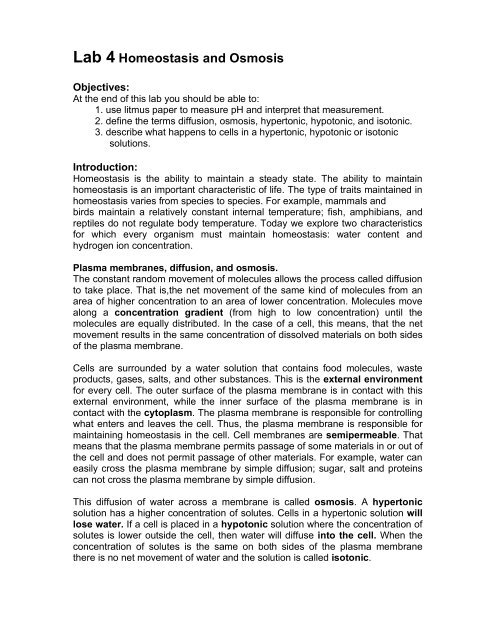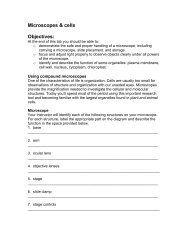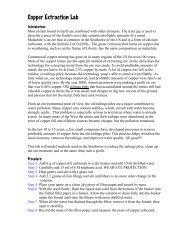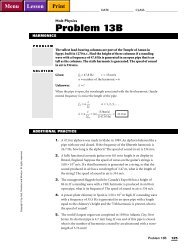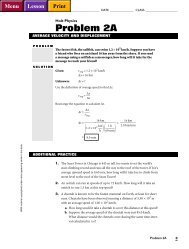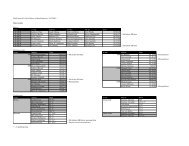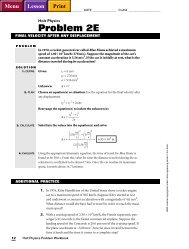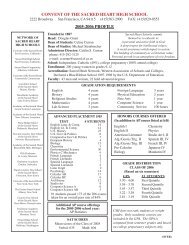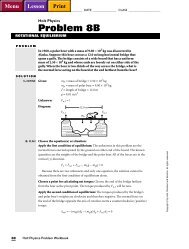Lab 4 Homeostasis and Osmosis
Lab 4 Homeostasis and Osmosis
Lab 4 Homeostasis and Osmosis
Create successful ePaper yourself
Turn your PDF publications into a flip-book with our unique Google optimized e-Paper software.
<strong>Lab</strong> 4 <strong>Homeostasis</strong> <strong>and</strong> <strong>Osmosis</strong><br />
Objectives:<br />
At the end of this lab you should be able to:<br />
1. use litmus paper to measure pH <strong>and</strong> interpret that measurement.<br />
2. define the terms diffusion, osmosis, hypertonic, hypotonic, <strong>and</strong> isotonic.<br />
3. describe what happens to cells in a hypertonic, hypotonic or isotonic<br />
solutions.<br />
Introduction:<br />
<strong>Homeostasis</strong> is the ability to maintain a steady state. The ability to maintain<br />
homeostasis is an important characteristic of life. The type of traits maintained in<br />
homeostasis varies from species to species. For example, mammals <strong>and</strong><br />
birds maintain a relatively constant internal temperature; fish, amphibians, <strong>and</strong><br />
reptiles do not regulate body temperature. Today we explore two characteristics<br />
for which every organism must maintain homeostasis: water content <strong>and</strong><br />
hydrogen ion concentration.<br />
Plasma membranes, diffusion, <strong>and</strong> osmosis.<br />
The constant r<strong>and</strong>om movement of molecules allows the process called diffusion<br />
to take place. That is,the net movement of the same kind of molecules from an<br />
area of higher concentration to an area of lower concentration. Molecules move<br />
along a concentration gradient (from high to low concentration) until the<br />
molecules are equally distributed. In the case of a cell, this means, that the net<br />
movement results in the same concentration of dissolved materials on both sides<br />
of the plasma membrane.<br />
Cells are surrounded by a water solution that contains food molecules, waste<br />
products, gases, salts, <strong>and</strong> other substances. This is the external environment<br />
for every cell. The outer surface of the plasma membrane is in contact with this<br />
external environment, while the inner surface of the plasma membrane is in<br />
contact with the cytoplasm. The plasma membrane is responsible for controlling<br />
what enters <strong>and</strong> leaves the cell. Thus, the plasma membrane is responsible for<br />
maintaining homeostasis in the cell. Cell membranes are semipermeable. That<br />
means that the plasma membrane permits passage of some materials in or out of<br />
the cell <strong>and</strong> does not permit passage of other materials. For example, water can<br />
easily cross the plasma membrane by simple diffusion; sugar, salt <strong>and</strong> proteins<br />
can not cross the plasma membrane by simple diffusion.<br />
This diffusion of water across a membrane is called osmosis. A hypertonic<br />
solution has a higher concentration of solutes. Cells in a hypertonic solution will<br />
lose water. If a cell is placed in a hypotonic solution where the concentration of<br />
solutes is lower outside the cell, then water will diffuse into the cell. When the<br />
concentration of solutes is the same on both sides of the plasma membrane<br />
there is no net movement of water <strong>and</strong> the solution is called isotonic.
<strong>Osmosis</strong> in synthetic cells.<br />
In this experiment a synthetic plasma membrane (dialysis tubing) is used to study<br />
osmosis. The solutions used inside the synthetic cells are simple sugar water<br />
(sucrose solution). Each team uses a different temperature <strong>and</strong> different<br />
concentration of sugar. At the end of class you will use the data collected by<br />
every team to explore the effect of solute concentration <strong>and</strong> temperature on<br />
osmosis.<br />
Experimental Design<br />
o Obtain a piece of dialysis tubing <strong>and</strong> secure one end with a plastic clip.<br />
o Fill about half the tubing with the proper solution.<br />
o Secure the other end of the tubing.<br />
o Completely dry your tubing <strong>and</strong> check for leaks.<br />
o Weigh your tubing on the appropriate scale.<br />
o Record your results on the chalk board <strong>and</strong> on the next page.<br />
o Place your tubing in the assigned water bath.<br />
o Dry <strong>and</strong> weigh your tubing at 10 minute intervals, each time recording your<br />
results on the chalk board <strong>and</strong> on the next page.<br />
Use the same scale for all measurements.<br />
Why is it important to use the same scale<br />
Sketch the experimental set up <strong>and</strong> make predictions:<br />
Cell soaking in a 40%<br />
sugar solution<br />
Cell soaking in a 20%<br />
sugar solution<br />
Cell soaking in a 5%<br />
sugar solution<br />
Will this cell gain water or<br />
loose water ________<br />
Will this cell gain water or<br />
loose water ________<br />
Will this cell gain water or<br />
loose water ________
Record the results for the entire class in the following charts.<br />
Warm<br />
Room<br />
Temp<br />
Cold<br />
# 1<br />
# 2<br />
# 3<br />
# 1<br />
# 2<br />
# 3<br />
# 1<br />
# 2<br />
# 3<br />
0 min 10 min 20 min 30 min 40 min 50 min 60 min<br />
total<br />
weight<br />
change<br />
1. What are the two independent variables for this experiment<br />
____________________________<br />
____________________________<br />
2. What is the dependent variable for this experiment<br />
____________________________<br />
3. What are some variables for this experiment<br />
____________________________<br />
____________________________<br />
____________________________<br />
4. Which solution had the lowest concentration of sugar (5%)<br />
__________________________________________________<br />
5. How could you tell<br />
________________________________________________________________<br />
_______________________________________________________________<br />
8. Which solution had the highest concentration of sugar (40%)<br />
_______________________________________________<br />
9. How could you tell<br />
________________________________________________________________<br />
_______________________________________________________________
10. Explain how concentration effects diffusion <strong>and</strong> osmosis.<br />
________________________________________________________________<br />
________________________________________________________________<br />
_______________________________________________________________<br />
11. Does your data support this explanation<br />
________________________________________________________________<br />
________________________________________________<br />
_______________________________________________________________<br />
12. Explain how temperature effects diffusion <strong>and</strong> osmosis.<br />
________________________________________________________________<br />
________________________________________________________________<br />
_______________________________________________________________<br />
13. Does your data support this explanation<br />
________________________________________________________________<br />
________________________________________________<br />
_______________________________________________________________<br />
Based on what you saw with the dialysis tubing: describe how it can be used for<br />
kidney patients:
<strong>Osmosis</strong> in onion skin cells.<br />
Changes in the amount of water inside a cell look very different in cells that have<br />
a cell wall. This experiment provides an opportunity to observe the effect of<br />
osmosis in onion cells. The solute is sugar.<br />
o Obtain a piece of red onion skin no larger than 1/4" square <strong>and</strong> one cell<br />
layer thick. (For best results, snap a single onion layer <strong>and</strong> then peel off<br />
the red cells.)<br />
o Place the onion skin on the slide, add a cover slip. This is your control.<br />
o Prepare a second slide as above except this time use a drop of 40% sugar<br />
solution. Make sure to use a cover slip!<br />
o Prepare a third slide as above except this time use a drop of 20% sugar<br />
solution. Make sure to use a cover slip!<br />
o Prepare a third slide as above except this time use a drop of 0% sugar<br />
solution. Make sure to use a cover slip!<br />
o Make sure you can tell your slides apart!!!! <strong>Lab</strong>el them somehow.<br />
o Using proper microscope techniques; view slides under high power (some<br />
slices may be too thick; you may have to use medium power).<br />
Plain onion cell with no solution<br />
Onion cell in<br />
a 40%<br />
solution<br />
Onion cell in<br />
a 20%<br />
solution<br />
Onion cell in<br />
a 0%<br />
solution<br />
14. Compared to the onion cell, is the 0% solution hypertonic, hypotonic, or<br />
isotonic _____________________<br />
15. Compared to the onion cell, is 20% sugar water hypertonic,<br />
hypotonic, or isotonic _____________________<br />
16. Compared to the onion cell, is 40% sugar water hypertonic,<br />
hypotonic, or isotonic _____________________<br />
17. Why did the plain slide act as a control in this experiment<br />
_________________________________<br />
18. Describe the independent variable in this experiment.<br />
_________________________________<br />
19. Describe the dependent variable in this experiment.<br />
_________________________________
<strong>Osmosis</strong> in red blood cells.<br />
Changes in the amount of water inside a cell look very different in cells that do<br />
not have a cell wall. This experiment provides an opportunity to observe the<br />
effect of osmosis in red blood cells. The solute is salt.<br />
o Place a drop of sheep blood on the slide, <strong>and</strong> add a cover slip. This is<br />
your control.<br />
o Prepare a second slide as above except this time use a drop of 10% salt<br />
solution. Make sure to use a cover slip!<br />
o Prepare a third slide as above except this time use a drop of 0.9% salt<br />
solution. Make sure to use a cover slip!<br />
o Prepare a third slide as above except this time use a drop of 0% salt<br />
solution. Make sure to use a cover slip!<br />
o Make sure you can tell your slides apart!!!! <strong>Lab</strong>el them somehow.<br />
o Using proper microscope techniques; view slides under high power. Call<br />
me over to check if your focus is correct; blood can be difficult to see.<br />
Plain blood cells with no<br />
solution<br />
Blood cell in a<br />
10% solution<br />
Blood cell in a<br />
0.9% solution<br />
Blood cell in a<br />
0% solution<br />
20. Compared to the blood cell, is the 0% solution hypertonic, hypotonic, or<br />
isotonic _____________________<br />
21. Compared to the blood cell, is 0.9% salt water hypertonic,<br />
hypotonic, or isotonic _____________________<br />
22. Compared to the blood cell, is 10% salt water hypertonic,<br />
hypotonic, or isotonic _____________________<br />
23. . Why did the plain slide act as a control in this experiment<br />
_________________________________<br />
24. Describe the independent variable in this experiment.<br />
_________________________________<br />
25. Describe the dependent variable in this experiment.<br />
_________________________________
pH, acidity <strong>and</strong> alkalinity.<br />
Perhaps no single change has a greater effect on our well being than a change in<br />
pH. If the pH of our blood is too low (acidic conditions) we feel depressed,<br />
sluggish <strong>and</strong> can even go into a coma. If the pH of our blood is too high (basic or<br />
alkaline conditions) we find that our nerve impulses increase <strong>and</strong> we become<br />
irritable or if the impulses get too fast we become rigid. Variations in pH of just a<br />
few tenths can be fatal.<br />
Interpreting pH<br />
26. Indicate what regions on the ph scale would be a strong acid, a strong base,<br />
a weak acid <strong>and</strong> a weak base.<br />
0 7 14<br />
27. Identify the following pH values as either acid or base <strong>and</strong> rank them in order<br />
of increasing strength.<br />
a. 9 b. 3 c. 12 d. 5<br />
e. 10 f. 7.3 g. 1.5 h. 6.5<br />
STRONG ACID _____ _____ _____ _____ WEAK ACID<br />
STRONG BASE _____ _____ _____ _____ WEAK BASE<br />
Measuring pH<br />
Chemicals that change color depending upon the presence of an acid or a base<br />
are called pH indicators. Litmus paper contains such a chemical <strong>and</strong> is<br />
commonly used to measure pH. By placing a drop of liquid on the paper <strong>and</strong> then<br />
comparing the paper's color to the accompanying color chart, you can estimate<br />
the pH. To see how this works, measure the pH of water. Now, being careful not<br />
to get the HCl or NaOH on your body or your clothing, measure the pH of the<br />
HCl <strong>and</strong> NaOH solutions.<br />
H 2 O: _____ HCl: _____ NaOH: _____
Measuring pH<br />
o In the lab today you will find a set of test tubes containing various liquids.<br />
Measure the pH for each liquid.<br />
o Do not attempt to taste these liquids <strong>and</strong> use caution if you try to smell<br />
these liquids.<br />
1. description:<br />
_______________________________________________________________<br />
pH = _____ , identity of liquid: ______________________________________<br />
2 description:<br />
_______________________________________________________________<br />
pH = _____ , identity of liquid: ______________________________________<br />
3. description:<br />
_______________________________________________________________<br />
pH = _____ , identity of liquid: ______________________________________<br />
4. description:<br />
_______________________________________________________________<br />
pH = _____ , identity of liquid: ______________________________________<br />
5. description:<br />
_______________________________________________________________<br />
pH = _____ , identity of liquid: ______________________________________<br />
6. description:<br />
_______________________________________________________________<br />
pH = _____ , identity of liquid: ______________________________________<br />
7. description:<br />
_______________________________________________________________<br />
pH = _____ , identity of liquid: ______________________________________<br />
8. description:<br />
_______________________________________________________________<br />
pH = _____ , identity of liquid: ______________________________________<br />
9. description:<br />
_______________________________________________________________<br />
pH = _____ , identity of liquid: ______________________________________<br />
10. description:<br />
_______________________________________________________________
pH = _____ , identity of liquid: ______________________________________


